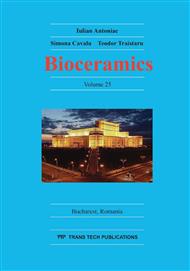p.255
p.263
p.269
p.275
p.282
p.287
p.293
p.297
p.303
CO2 Laser Assisted Processing of Bioactive Titanium-Based Surfaces
Abstract:
The surface of Ti6Al4V alloys was activated by a selective laser microstructuring and subsequent sintering of hydroxyapatite (HAp) nanopowders into the generated structures. For structuring, a novel q-switched CO2 laser with pulse durations of about 600 ns and a peak power of up to 60 kW was used. This laser system provides defined blind holes and channel-like geometries with structural sizes in the range of 100-500 μm. The influence of different process gases (Ar, O2, N2) on the formation of titanium oxide (TiO2) and titanium nitride (TiN) interfaces during laser structuring was investigated by GDEOS. HAp nanopowders prepared by a wet-chemical synthesis route were subsequently sintered into the generated structures using a CO2 laser with continuous radiation intensities up to 2·102 W/cm2. The homogeneously sintered structures consist of HAp as the major phase and minor amounts of tricaliumphosphate (TCP) and tetracalciumphophate (TTCP). The formation of TCP and TTCP during laser sintering can be minimized by adjusting sintering parameters (time, laser intensity) and by applying additional process gases (O2, Ar).
Info:
Periodical:
Pages:
282-286
Citation:
Online since:
November 2013
Authors:
Price:
Сopyright:
© 2014 Trans Tech Publications Ltd. All Rights Reserved
Share:
Citation:


